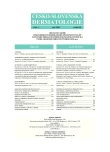Contact Dermatitis
Authors:
A. Vocilková
Authors‘ workplace:
Kožní ordinace, Poliklinika, Praha
6
Published in:
Čes-slov Derm, 80, 2005, No. 5, p. 252-260
Category:
Reviews
Overview
The term contact dermatitis includes skin changes due to acute irritation – acute irritant contact dermatitis (ACID), chronic inflammatory changes due to repetitive irritation of skin surface – chronic cumulative irritant contact dermatitis (CHCID) and eczema lesions caused by delayed hypersensitivity – allergic contact dermatitis (CAD) – allergic contact eczema.
It is hardly possible to estimate an incidence of diseases from contact dermatitis group (irritant and allergic). Mild skin irritation due to working activity in certain occupations or due to non-professional contacts is mostly regarded as a normal condition not requiring treatment. It has been estimated that acute and chronic contact dermatitis represents approximately 5–15% of dermatoses treated by a dermatologist. About 2–9% of population suffers from contact allergy. Contact allergic dermatitis occurs in 20–90% of reported professional dermatoses. Aetiology of hand eczema-dermatitis has been estimated to be atopic in 36%, contact allergic in 23%, cumulative toxic in 21% and 20% is represented by a nummular microbial eczema.
The most common contact allergen is nickel (7% of population – in young women even 20% sensitised). Recently the number of diagnosed contact allergic reaction to cosmetic preparations components increases. In specialized clinics performing patch-testing the percentage of allergic reactions to cosmetic components has been estimated to 6%.
In patients with suspected contact dermatitis the patch tests are performed for confirmation of allergic effect of substances, which are in contact with the skin. Nowadays, the standard patch test series of allergens consists of 25 tests with particular substances or composit tests containing a group of allergens of related nature.
Preventive measures have an essential influence on an occurrence of contact dermatitis. If acute signs are present, except for elimination of provoking factor responsible for skin changes, it is useful to apply an effective antiinflammatory substances (usually corticosteroids of the 3rd class in suitable vehicle) and oral antihistaminics blocking itching. Cases when systemic hormonal treatment is needed are not exceptional.
Key words:
allergic contact dermatitis – acute irritant contact dermatitis – chronic cumulative irritant contact dermatitis
Labels
Dermatology & STDs Paediatric dermatology & STDsArticle was published in
Czech-Slovak Dermatology

2005 Issue 5
Most read in this issue
- Contact Dermatitis
- Seborrheic Dermatitis
- Incidence Monitoring of Contact Sensitization to Selected Adjuvants in Dermatologic Topical Medications and Cosmetics in Patients with Eczema – Results and Conclusions of a grant project
- Contact Sensitization to Selected Adjuvants in Dermatologic Topical Medications and Cosmetics in Relation to Eczema Localization
